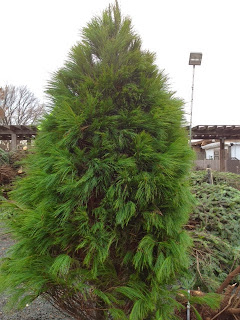For those that love the tradition of a fresh cut tree, the wonderful choices available now may seem overwhelming. Sure, there are a lot of things to consider. How long will the tree be up? How tall? How wide? Do I want a dense tree or a layered one? Do I wrap the branches with lights or just lasso the outside? Can the branches support my big, heavy ornaments? Don't be overwhelmed. Choices abound:
Fraser fir is now the standard all quality varieties are compared against. The green needles with silver undersides impart a Christmas-y evergreen fragrance to holiday festivities. There are many strong branch tips to support lots of beautiful ornaments. Do be sure to check the trunk before you go home. Frasers tend toward very thick trunks (even at smaller sizes) that may require something other than a "ring stand". You'll love the great needle retention that allows you to have your Fraser up for a long holiday season.
Canaan fir is a relatively new selection. There is some variability in appearance so they can sometimes be confused with either Balsam, or even Fraser. The needles are soft (read easy to decorate), but branches are stiff enough to support ornaments. Needle retention is very good, and the aroma mimics Balsam, the most familiar Christmas tree-scent.
Another newer introduction to the Midwestern Christmas palette is Nordmann fir. It possesses soft, flattened black-green needles. While the fragrance is light, needle retention is excellent. Incidentally, Nordmanns are quite popular in Europe.
Noble fir is apropos for an elegant tree. The needles are not flattened, but tend to encircle the branches. They're a handsome blue-green and give off a wonderful aroma. The branches are beautifully layered and strong. Big heavy ornaments? Nobles' thick stems handle those easily. Their incredible needle retention is bested only by Concolor firs. You can have them indoors for weeks and weeks, literally. Like Frasers, they have thick trunks that require large diameter, heavy duty stands.
Then there's Concolor fir. If you're the family that puts your tree up in November and takes it down as the Super Bowl nachos are coming out of the kitchen, this is the tree for you. The long, soft silver-blue, silver-green needles are a joy to decorate. And they last! A friend wanted to really test her Concolor's needle longevity. In February she put her Christmas Concolor outside on the deck. In April she took a picture with all the needles still attached. Rusty brown to be sure, but still attached. No shedding, no kidding! No other tree is up to that challenge. Not that you still want your tree up in April, but it's a statement. The other thing is the delightful citrusy fragrance released when the tree is brought into a warm room. You'll swear someone's smuggled an orange tree into your home. The fragrance endures as the days and weeks pass. Incredible.
White pines have a different appearance than the firs. Their long, soft needles shed minimally. They are typically sheared in the nursery so they tend to be densely tufted on the outside without a lot of interior branching. The fragrance is wonderfully predictable- pine forest. The overall impression is "fluffy".
Now, if the tree fits in the stand, looks relatively straight, stays upright and all the lights stay on without blowing a circuit, that's about as stress-free as Christmas gets!








